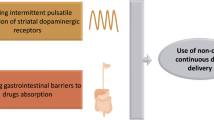Abstract
Continuous dopaminergic stimulation is the ideal approach for the management of Parkinson’s disease (PD); this goal can be partially reached with dopamine agonists, but the need for a therapeutic strategy providing a strong and constant dopaminergic stimulation also in the advanced phase of the disease remains unmet. The application of levodopa/carbidopa-gel suspension directly in the duodenum (Duodopa) allows a continuous delivery by a portable pump, resulting in smoother levodopa plasmatic concentrations, and consequently in a physiologic continuous receptor stimulation. Clinical studies have demonstrated that duodenal infusion was associated with significantly better outcome compared to conventional treatment regarding global functioning, ability to walk, “off” time and motor fluctuations. A retrospective analysis of the long-term clinical experience with Duodopa evidenced that daily dose of levodopa decreased by 5% during follow-up. The profile of pharmacological adverse events of Duodopa was similar to that observed with oral administration; dislocation of the intestinal tube to the stomach was the most common technical problem.
Similar content being viewed by others
References
Antonini A (2007) Continuous dopaminergic stimulation — from theory to clinical practice. Parkinsonism Relat Disord 13[Suppl]:S24–S28
Nyholm D, Askmark H, Gomes-Trolin C (2003) Optimizing levodopa pharmacokinetics: intestinal infusion versus oral sustained-release tablets. Clin Neuropharmacol 26:156–163
Nyholm D, Nilsson Remahl AI, Dizdar N et al (2005) Duodenal levodopa infusion monotherapy vs oral polypharmacy in advanced Parkinson’s disease. Neurology 64:216–223
Nyholm D, Lewander T, Johansson A et al (2008) Enteral levodopa/carbidopa infusion in advanced Parkinson disease: long term exposure. Clin Neuropharmacol 31:63–73
Eggert K, Schrader C, Hahn M et al (2007) Continuous jejunal levodopa infusion in patients with advanced Parkinson’s disease: practical aspects and outcome of motor and non-motor complications. Clin Neuropharmacol 31:151–166
Antonini A, Isaias IU, Canesi M et al (2007) Duodenal levodopa infusion for advanced Parkinson’s disease: 12-month treatment outcome. Mov Disord 22:1145–1149
Antonini A, Mancini F, Canesi M et al (2008) Duodenal levodopa infusion improves quality of life in advanced Parkinson’s disease. Neurodegener Dis 5:244–246
Author information
Authors and Affiliations
Corresponding author
Rights and permissions
About this article
Cite this article
Odin, P., Wolters, E. & Antonini, A. Continuous dopaminergic stimulation achieved by duodenal levodopa infusion. Neurol Sci 29 (Suppl 5), 387–388 (2008). https://doi.org/10.1007/s10072-008-1054-7
Published:
Issue Date:
DOI: https://doi.org/10.1007/s10072-008-1054-7




